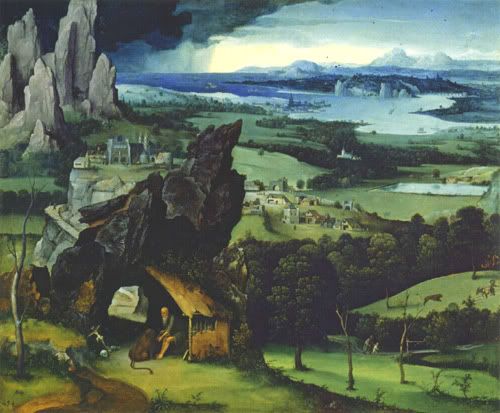The Paintings of Patinir
Although I have been familiar with Joachim Patinir's Charon Crossing the Styx for some time, I have tended to pass over his paintings and the works of his contemporaries (e.g. Heironymus Bosch and Herri met de Bles). Yesterday, however, a visit from my godfather awoke in me an appreciation for Flemish Northern Renaissance landscape paintings.
My godfather had recently gone to the Museo Nacional del Prado (in Madrid) to see the world's first Patinir exhibition. When he came to visit us, he brought with him postcards, catalogues, and pamphlets from the exhibition. On looking over them, I was immediately struck by the deep greens and blues of the paintings -- the Landscape with St. Jerome, for example.

I really like how, in the above landscape as in others, the rich greens and browns in the foreground fade to paler blue-greens, faint blue, and finally to rich blue in the distance. The overall effect is pleasing, and not as chaotic as some of Bosch's paintings.
Although I find Patinir's use of colour delightful in itself, the real charm of his paintings lies in the details. If one looks closely, one can find many entertaining little scenes scattered throughout his paintings. To begin with, there is the main subject (usually a biblical one -- St. Jerome, in this case), which is often surprisingly small and inconspicuous.

Then, there are various further figures -- human and otherwise -- in the surrounding countryside. Here, for example, a lion is attacking an unfortunate traveller and his donkey:

Better examples can be found in Landscape with the Rest on the Flight into Egypt.

In the painting, at the right, soldiers can be seen advancing through a small village and nearby fields. I am not particularly familiar with the Bible, so my understanding of the scene is limited. Considering the title of the painting, however, I assume that the soldiers are killing the male infants on Herod's orders.

I'm not sure what exactly the strange temple-like building is in the detail below. At any rate, if you look closely, you can see a monster sitting on one of the towers. It seems to be accepting sacrifices (e.g. a bird and a sheep or goat).

The temple-like building and the fortress on the hill are both examples of the interesting architectural specimens that are scattered throughout Patinir's landscapes. The Landscape with St. Jerome has many such buildings and towns. In the next detail, you can dimly see the most distant of those towns, complete with a long bridge, roofs, steeples, and sailing ships.

The following detail is, in retrospect, rather pointless. I think I chose it mainly because of the colours. Oh well. It also includes some of the massive towering rocks that are frequently found in the paintings.

To finish off, here is part of Bosch's famous triptych, The Garden of Earthly Delights (from the WebMuseum).

Disordered or not, I must admit that there is more going on in Bosch's paintings. In the above detail, there is truly a wealth of fascinating creatures. One could spend a considerable amount of time examining the creatures and the fantastical, somewhat futuristic, landscape.
Note: The Landscape with St. Jerome images are taken from a Museo del Prado postcard. The postcard is only about 10 x 12 cm, so the details aren't very clear (sorry).
Another Note: The Landscape with the Rest on the Flight into Egypt images are taken from another (larger) Museo del Prado print. The print is approximately 20 x 30 cm, and the actual painting is 121 x 177 cm (about 48 x 70 inches).
Final Note: All the images were edited using Adobe Photoshop. The colours, brightness, contrast, and so on, are inevitably different from those of the actual painting (sorry again).

0 Comments:
Post a Comment
<< Home